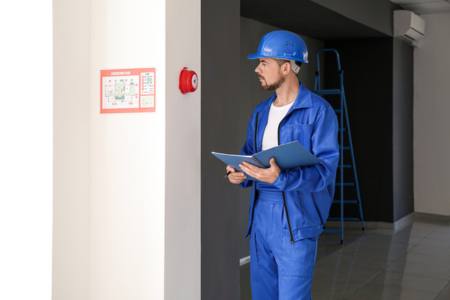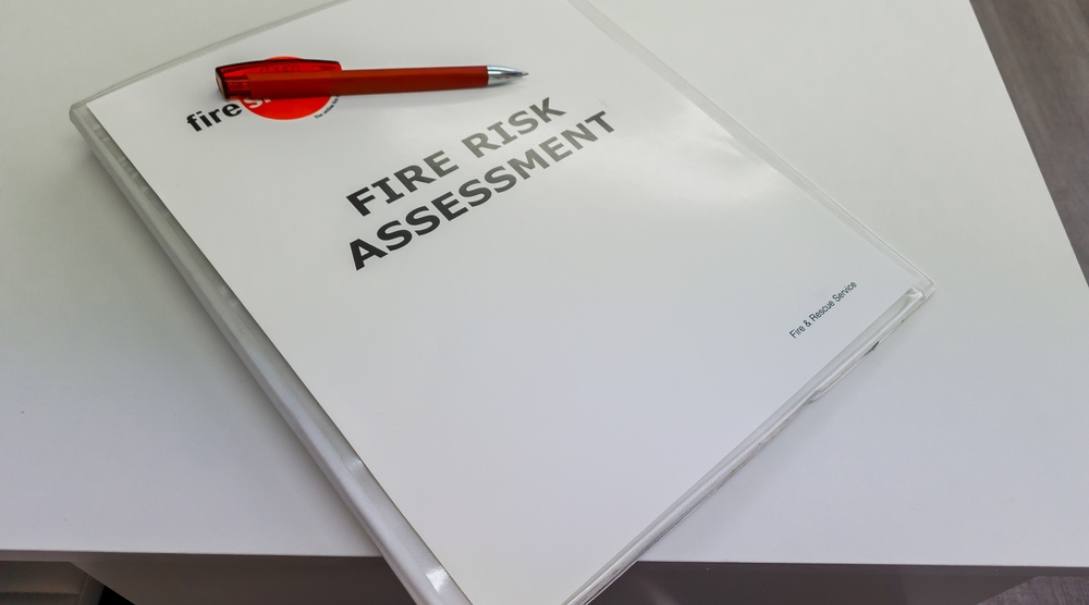Few actions carry as much weight as conducting a thorough fire risk assessment. By identifying potential fire hazards, assessing the likelihood of a fire breaking out, and recommending measures to mitigate these risks, fire risk assessments serve as a critical tool in ensuring the safety of individuals and the protection of properties.
Table of Contents
What Are Fire Risk Assessments?

Hazard Identification
- Broad Scope of Hazard Identification: Assessors conduct a sweeping search for potential fire sources. This includes checking for overloaded electrical circuits, which, according to the Electrical Safety Foundation International, are a leading cause of home fires.
- Assessment of Material Properties: The flammability of materials used in a building’s construction and interior is evaluated. For instance, materials like polyurethane foam, often used in furnishings, pose a high fire risk due to rapid flame spread.
Risk Evaluation
- Quantitative Risk Analysis: This involves statistical analysis, like calculating the Fire Risk Index, a method that quantifies a fire’s likelihood and potential impact.
- Vulnerability Assessment: Special attention is given to the vulnerability of occupants, especially in buildings like hospitals or care homes where mobility may be limited.
Safety Recommendations
- Customized Fire Safety Plans: Based on the assessment, specific action plans are created, which might include installing Class A fire extinguishers in areas with combustible materials.
- Emergency Response Procedures: Recommendations for emergency procedures are tailored, considering factors like building layout and the number of occupants.
Legal Requirement
- Compliance with Standards: In many regions, these assessments are mandated by OSHA and/ or NFPA regulations.
- Regular Audits and Inspections: Regular compliance audits are often required to ensure ongoing adherence to fire safety standards.
Cost-Benefit Analysis
- Financial Implications: The U.S. Fire Administration reports that the average cost of a commercial fire is significantly higher than the cost of a comprehensive risk assessment.
- Insurance Considerations: Effective fire risk management can lead to lower insurance premiums due to reduced risk profiles.
Professional Expertise
- Cross-Disciplinary Knowledge: Assessors often have expertise in multiple areas, including fire engineering, building design, and emergency planning.
- Continuing Professional Development: They undergo ongoing training to stay abreast of the latest fire safety research and technological developments.
In essence, fire risk assessments are a critical component of safety management, combining meticulous inspection with expert analysis to create safer environments. They are indispensable for anyone responsible for property safety, from business owners to landlords, emphasizing prevention and preparedness as key to protecting lives and assets.
Fire Risk Assessment Cost

Factors Influencing Cost:
- Property Size and Complexity: For a small property or office, costs might range from $200 to $600, while larger buildings or complex environments could see prices from $1,000 to $5,000 or more.
- Location: In metropolitan areas where the cost of living is higher, you might expect to pay 10-20% more than in rural areas.
- Assessor Expertise: Senior assessors with specialized experience may charge anywhere from $100 to $300 per hour, depending on their qualifications and the region.
- Scope of Assessment: A basic visual walkthrough might be on the lower end, while a detailed assessment with comprehensive documentation could be much higher.
- Frequency of Assessments: Initial assessments are more costly, but subsequent annual reviews might range from 30% to 50% of the initial cost.
Understanding the Investment:
- Prevention vs. Cost: The National Fire Protection Association (NFPA) reports that the average commercial fire can cause upwards of $20,000 in damages, far surpassing the cost of most assessments.
- Insurance Benefits: Some businesses report up to a 10% discount on insurance premiums after implementing rigorous safety assessments and measures.
- Long-Term Savings: Early hazard detection can prevent losses that far exceed the assessment’s cost. For instance, electrical fire damage can easily exceed $10,000, not including business interruption losses.
- Compliance and Legal Protection: Fines for non-compliance can range from a few hundred to tens of thousands of dollars, depending on the jurisdiction and severity of the oversight.
Budgeting for an Assessment:
- Get Multiple Quotes: Costs can vary widely, so obtaining quotes from several assessors is crucial. The average market rate can be anywhere from $500 to $2,500 for medium-sized premises.
- Consider the Value: Weigh the assessor’s experience against their fees. Remember, a more expensive assessment might provide greater depth and protection.
- Plan for Regular Reviews: Set aside a yearly budget for ongoing assessments. For a small to medium-sized business, this might be in the range of $300 to $1,500 annually.
While the cost of a fire risk assessment can vary widely based on numerous factors, its value in safeguarding lives, property, and business continuity is undeniable. Understanding and planning for this expense is a crucial aspect of responsible property management and a proactive step toward a safer future.
The Role of Professional Assessors
While it’s possible to conduct a preliminary fire risk evaluation independently, the expertise of professional assessors is invaluable. These specialists bring a wealth of experience and knowledge to the table, ensuring that no stone is left unturned. Here are some of the benefits of a professional assessor:
| Benefit | Description |
| Expert Knowledge | Professional assessors are well-versed in fire safety laws and regulations, staying updated on the latest standards and technologies. |
| Detailed Inspection | They conduct thorough inspections, identifying obvious risks and subtle hazards that untrained individuals might overlook. |
| Risk Analysis | Assessors analyze each hazard’s potential impact, considering various factors like property layout and occupancy. |
| Tailored Recommendations | They provide customized advice based on the specific needs and vulnerabilities of the property, suggesting practical measures to enhance safety. |
| Comprehensive Reports | The reports provided are detailed and actionable, serving as a roadmap for property owners to improve safety and comply with regulations. |
| Education and Training | Beyond assessments, professional assessors often offer training for staff and occupants to understand safety roles and emergency actions. |
| Cost-Efficiency Analysis | They help property owners understand the long-term financial benefits of proper safety measures and potential savings. |
| Ongoing Support | Many assessors offer continuous support, updating assessment |
This table encapsulates the multifaceted roles of professional fire risk assessors. From their deep understanding of safety regulations to their ability to provide actionable recommendations, these experts are crucial in navigating the complexities of fire safety.
Guidelines for Choosing a Fire Risk Assessor

- Qualifications and Certifications: Prioritize assessors with certifications from reputable bodies like the National Fire Protection Association (NFPA) or the Institution of Fire Engineers (IFE).
- Sector-Specific Experience: The fire safety challenges in a manufacturing plant differ vastly from those in a residential complex. For instance, the NFPA reports distinct fire hazard profiles across different industries.
- Track Record and Client Testimonials: Look for an assessor with a strong track record, positive client feedback, and indicators of expertise and reliability.
- Local Regulation Expertise: The complexity of fire safety regulations varies regionally. For example, the International Building Code (IBC) and the International Fire Code (IFC) are widely adopted in the United States, but local adaptations can occur.
- Detailed Assessment Methodology: The best assessors use a holistic approach, considering factors like building layout, occupancy, fire detection systems, and evacuation protocols.
- Effective Communication: A survey by the Fire Protection Association highlighted communication as a key skill for fire risk assessors. Understanding complex safety issues is crucial for effective risk mitigation.
- Continuity and Post-Assessment Support: Fire risk assessment is not a one-off task but an ongoing process. Professionals offering regular reviews, updates, and support in implementing recommendations are more valuable in the long term.
- Insurance and Professional Liability: A responsible assessor carries professional indemnity insurance, demonstrating professionalism and providing you with a safety net in the rare event of an oversight.
- Transparent and Justifiable Costs: The NFPA’s cost-benefit analysis of fire prevention strategies underscores the importance of cost transparency in fire risk assessments. Ensure that the fees are clearly explained and justified in terms of the value delivered.
- Personal Compatibility: The Human Factors and Ergonomics Society highlights the importance of personal rapport in safety-related collaborations. A strong working relationship fosters better understanding and more effective implementation of safety measures.
By following these detailed guidelines, you’re investing in a partnership that prioritizes your property’s and its occupants’ safety. This decision, grounded in thorough research and careful consideration, will contribute significantly to your overall fire safety strategy.
Work With Our Fire Risk Assessors
Don’t wait for a fire incident to underline the importance of fire safety. Be proactive. Whether you’re a property owner, a business manager, or a landlord, now is the time to take action.
Engage AOTC’s specialized environmental compliance services for a comprehensive fire risk assessment. Our certified professionals are ready to provide an evaluation customized to your unique requirements. Your proactive decision today is your security tomorrow.
Contact AOTC today to get started. Let’s make safety a shared priority.
